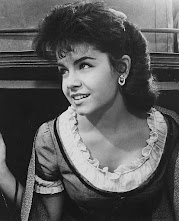In support of
National Classic Movie Day on May 16th, we are participating in the Classic Movie Blog Association's
Big Stars on the Small Screen blogathon. This blogathon focuses on classic film stars who appeared in TV series, miniseries, variety shows, made-for-TV movies, and even commercials. Check out all the
blogathon entries! Our post takes a look at the short-lived 1971-72 TV series
The Jimmy Stewart Show. |
| James Stewart in Fools' Parade. |
1. The year 1971 was a pivotal one in the career of James Stewart. He appeared in
Fools' Parade, the last theatrical film in which he'd be the principal star and made his debut in his own weekly TV series.
The Jimmy Stewart Show premiered on NBC on September 9, 1971 while
Fool's Parade was released the following month. The film received mixed reviews (I'm a fan...read my
review here), but was a box office disappointment. I suspect the 63-year-old Stewart knew that he was at a career crossroad and when Warner Bros. offered to make him one of TV's highest paid stars, he seized the opportunity.
2. Film director and writer Hal Kanter created The Jimmy Stewart Show. Kanter must have seemed like the perfect choice, having received acclaim for his popular Emmy-nominated TV series Julia (1968-71). Plus, Kanter worked with James Stewart on the theatrical film Dear Brigitte (1963). Indeed, Kanter had tried to lure Stewart to TV in the mid-1960s. The goal was to develop a half-hour family comedy with Stewart playing an anthropology professor who taught at Josiah Kessel College in the quaint California town of Easy Valley.
3. The original intent was that James Stewart's wife, Gloria, would play his TV spouse. However, according to Marc Eliot in his 2007 book Jimmy Stewart: A Biography, NBC "decided she wasn't good enough an actress to pull it off." After an extensive search, Julie Adams, who co-starred with James Stewart in the 1952 Western classic Bend of the River, was cast as the professor's wife. She was 18 years younger than Stewart.
4. When I
interviewed Julie Adams in 2013, she told me: "As I recall, a lot of women read for the role of Martha Howard, the wife of Professor James K. Howard (Stewart). The day I tested for the part with Jimmy, I brought into play my genuine friendship and admiration I had for him as a person. I think that came through on the screen; we had nice chemistry together. After the screen test, he gave me a little nod and as I walked back to my dressing room I thought: "I think I have this part!" I was so thrilled. The show was not a success, and only lasted 24 episodes. But, as I've often said: My idea of heaven was going to work with Jimmy Stewart every day for six months."
5. Each episode opened and ended with James Stewart speaking directly to viewers. Here's an example: "This week, we have that distinguished actor, Vincent Price, with us. So we called this episode Price Is Right. You know, fair is fair." Each episode ended with Jimmy telling the television audience: “My family and I wish you peace, and love, and laughter.”
 |
| Veteran actor John McGiver. |
6. In addition to Julie Adams, the other notable cast members were John McGiver, who played Jim Howard's faculty colleague Dr. Luther Quince, and Mary Wickes (who appeared in four episodes). The guest stars included a nice mix of veteran actors and up-and-coming talent: Vincent Price, Cesar Romero, Jack Soo, Kate Jackson, Will Geer, Gloria DeHaven, William Windom, Jackie Coogan, Beulah Bondi, Regis Philbin, M. Emmet Walsh, Nita Talbot, and Pat Buttram. Gloria Stewart may not have gotten to play her husband's wife, but she did appear in the show's first episode "By Way of Introduction."
 |
| James Stewart in Hawkins. |
7. Despite being sandwiched between Top 20 shows
The Wonderful World of Disney and
Bonanza on Sunday night,
The Jimmy Stewart Show was a ratings disappointment. Its cancellation after a single season was not a surprise. Allegedly, James Stewart was relieved as the film schedule was more work than he anticipated. The famed actor wasn't done with television, though. In 1972, he reprised his performance as Elwood P. Dowd in a
Hallmark Hall of Fame production of
Harvey. Its cast featured Helen Hayes and his
Jimmy Stewart Show co-star John McGiver. The following year
, Stewart starred as as homespun lawyer Billy Jim Hawkins, who took on headline-making cases in the 90-minure drama
Hawkins. The episodes were rotated with the
Shaft TV series and CBS made-for-TV movies so that only eight episodes of
Hawkins were aired. You can read our review of
Hawkins here.























.jpg)












.png)
















